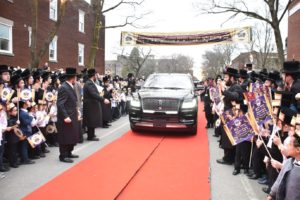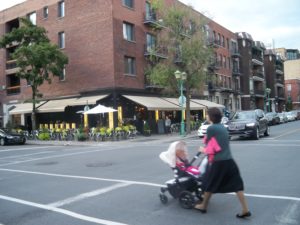At the December meeting of the Outremont, Que., borough council, something unprecedented happened: sufganiyot, which were ordered from a local kosher bakery, were served, courtesy of council.
Goodwill has been extended in both directions in recent months in the Montreal borough of Outremont, where for at least 30 years, tensions between the Hasidic and francophone populations have simmered and frequently boiled over.
In April, on the eve of the first visit in more than two decades of Belzer Grand Rabbi Yissochar Dov Rokeach from Israel, a historic occasion for the community, Outremont residents found a letter in their mailboxes. It politely explained the significance of his visit and advised residents that there would be large crowds on the streets, but that the community was endeavouring to keep activities away from residential neighbourhoods and working with authorities to minimize the inconvenience.

Thousands, many of whom came from New York, lined Jeanne Mance Street, outside the main Belzer synagogue, and even more turned out for the Lag ba-Omer festivities, which included a tent that could accommodate more than 5,000 people and a huge bonfire.
In years past, even much smaller public events would have been cause for vocal complaints, but this time, objections were few and restrained, say organizers. In fact, a significant number of non-Jews joined in the excitement.
In appreciation, the Belzer community placed a full-page ad in a local newspaper, thanking “our dear neighbours,” as well as the municipal government and the police, for helping the event go off without a hitch.
A positive atmosphere is discernible in Outremont these days, which Hasidic and non-Hasidic residents attribute to the changes at the borough council, following the municipal elections in November. Four of the five seats are now held by Projet Montréal members, including the newly elected mayor, Philipe Tomlinson, and the re-elected Mindy Pollak, the first Hasidic woman to hold public office in Quebec.
Tomlinson helped set the tone when he stated: “We live in one of the best areas in the world. We live in a very privileged situation.… Let’s work on what unites us and we will diminish what divides us.”
“There’s definitely a change,” said Pollak. “The council plays a huge role in setting the tone of what goes on. Past councils have sort of encouraged the conflict.”
The new mood is also the fruit of years of grassroots efforts by Outremont residents to engage in dialogue and find constructive ways to deal with the issues.
There have been long-running grievances levelled against the Hasidim about illegal synagogues, customs considered unsightly (such as sukkot and burning the hametz), as well as traffic, parking and noise issues that have been the subject of numerous council meetings and resulted in restrictions placed on the community. Although some of the complaints were justified, the Hasidic community saw the mounting regulations as a naked attempt to drive them out.
READ: YIDLIFE DUO EXPLORE KRAKOW’S FASCINATION WITH JEWISH CULTURE
The most divisive fracas of late was a bylaw passed in 2016 that banned any new places of worship on Bernard and Laurier avenues, on the grounds that commercial activity on the major arteries had to be revitalized. The Hasidim, who were planning to build another shul on Bernard Avenue, objected vigorously and threatened legal action. A referendum ultimately upheld the bylaw.
Nanci Murdock, who spearheaded the campaign to limit the development of new shuls, objects to the “vilification” of those who support the ban.
Writing in the Huffington Post in 2016, she said that “we are certainly not afraid of diversity,” but argued that the lack of “a healthy balance of secular and non-secular activity” on Bernard Avenue could adversely affect merchants on the street.
Some residents have found the Hasidim’s traditional insularity unfriendly, and their overt religiosity regressive. What has simplistically been portrayed as a clash of cultures became more pronounced when Outremont – which has historically been the home of the wealthy, francophone elite – transitioned from a city to a borough in the early 2000s.
The rhetoric intensified during Quebec’s contentious secular values and reasonable accommodation debate. That was around the time when Pierre Lacerte, a resident who would regularly show up at council meetings to complain about the Hasidic community, launched a caustic blog called Les Accommodements Outremont. His aim was to expose alleged violations by Hasidim, whom he often ridiculed, maintaining that he had to do it because successive councils were too lenient with the community.
It was an intrusive pursuit that provoked a lawsuit from a Hasidic leader, as well as a counter-lawsuit. But even Lacerte has given up: he shut down the blog in December, after running it for 10 years.
Throughout these years, the number of Hasidim (largely Belz, Satmar, Vizhnitz and Bobov), who typically have high birth rates, has increased dramatically.
Those with grievances against them have not disappeared entirely. A small group showed up at the March borough council meeting with yellow pieces of fabric pinned to their shirts, as a protest against the proliferation of yellow school buses that are used by the Hasidim. That it would offend Jews because the badges were reminiscent of the Holocaust apparently did not dawn on the protesters, who remained unapologetic.
Soon after, Mayor Tomlinson promised to set up a committee, called Bon Voisins (Good Neighbours), composed equally of Hasidic and non-Hasidic residents, to resolve conflicts. That committee was recently approved by council.
“I’m very happy that citizens have chosen a path of working together, rather than conflict with no end in sight,” said Pollak.
However, she is not certain whether bylaws targeting the Hasidim can be repealed and said that reopening the places of worship interdiction is not in the cards at the moment. “It’s tricky. It’s going to take some planning. We’re not tackling it yet,” said Pollak.
That bylaw does allow for new religious institutions in the northeast zone, an old industrial area where the Université de Montréal is building a new campus.

As for the school bus grievance, Pollak said a police report shows that the buses pose no risk to public safety. “There are a lot of kids, it’s a busy neighbourhood. It’s just what it is,” she said.
Pollak is hopeful that the new committee will find long-term solutions to some of these problems. “We want to tap into our citizens and figure out together how to best move forward,” she said.
Pollak said her first four years on council were very stressful, but that’s all changed.
“I didn’t realize how bad it was. Now I’m excited to go to work. Now we have a team, we are brainstorming and it’s wonderful,” she said. “The citizens are the winners. There’s a vision now.”
Chudi Herzog, whose husband, Samuel, was one of the organizers of the Belzer rebbe’s visit, is heartened by how smoothly it went and how few complaints in garnered – a sign that life in Outremont is changing for the better.
“Day-to-day life is more congenial,” she said. “We say hello to each other, it’s easier.”
The Herzogs, who have eight children, appreciate how the Hasidic kids are being welcomed by the community. At the same time, there is a greater understanding of why they can’t always play with the other kids.
“I explain that we teach our children to respect others, but because our lifestyle is so different – for example, we don’t expose them to the Internet – it’s not possible,” said Herzog. “People totally understand that it’s not because we think we are better. It’s important to talk and share.”
Alex Werzberger, who has lived in Outremont since 1950 and is the longtime president of the Coalition of Outremont Hasidic Organizations, agrees that things have been changing for the better, especially on the borough council.
“Numbers talk in politics. We are now at least 35 per cent of the population – and growing. When I first bought a house on Querbes (Avenue), I was almost the only Jew. Today, maybe there are two or three non-Jews,” said Werzberger.
Lower Outremont is “solidly Jewish now,” he added.
In fact, the community is increasingly spilling over into the neighbouring Plateau Mont-Royal borough – without opposition.
“Park Avenue, between Bernard and Van Horne, is becoming synagogue alley, with six or seven new ones,” he pointed out, and with no deleterious effect on businesses in the area.
Werzberger maintains that the vitriol directed at the Hasidim has always been limited, saying that “there never really were hard feelings among neighbours, between Jews and francophones. (That impression) was artificially made by a small clique that was always running to the council.”
They found a sympathetic ear in independent councillor Céline Forget, who was defeated in November.
Diane Shea has lived in Outremont and the adjacent Mile End district for close to 40 years. She is a member of the Friends of Hutchison, a grassroots organization that was formed several years ago, when there was concerted opposition to the expansion of a shul on the street.
The group – which was founded by Leila Marshy, who is of Palestinian heritage, and Pollak, before she ever dreamt of entering politics – spearheaded a campaign to unite Hasidim and non-Hasidim.
They organized the first “town hall” meeting, in which Hasidic and non-Hasidic residents met face-to-face for reasoned discussion.
“We now have a council that does not intend to use bylaws to stifle the activities of the Hasidic community,” Shea said. “Tomlinson has said very clearly that he wants dialogue and you can already feel a lifting of the tension. The new administration is not afraid to show leadership … and has opened the door to a more civilized way of moving forward.”
She views the problems of the past as stemming from “a small number of troublemakers – radical secularists” who are not representative of the population.
Shea noted that the Belzer rebbe’s visit seems to have been a turning point. “One man said at the following council meeting that he appreciated the efforts of the Belzer community to inform everyone before the event with leaflets that were in French,” she said.
A newer group called Pluralisme Outremont was started by parents of different backgrounds who want children to be raised with an appreciation of diversity. They were the ones who told the yellow-square wearers at the council meeting that their choice of symbol was insensitive.
Thanks to Pluralisme Outremont’s efforts, the borough’s annual spring fair, which was held in June, was extended into Sunday, rather than only taking place on Saturday, so that the Hasidim could participate. The group had requested that change last year, but were refused by council. The Hasidic community was pleased to be able to take part in this year’s festivities.
Resident Rani Cruz is optimistic about the future.
“I feel the Hasidic community, especially with the rabbi’s visit, has made real efforts to reach out to neighbours and invite them to participate in the celebrations. I took my kids to the procession in the daytime and also went to the bonfire, which was festive and inclusive,” she said.
“I think that many in the Hasidic community feel more secure to open themselves up.”
Cruz also said that Hatzolah, the Hasidic community’s volunteer emergency medical service, will be helping man the first aid tent at an upcoming run.
“When I asked, there was no hesitation,” she said.









